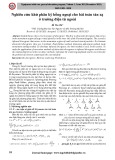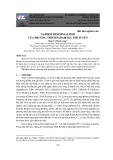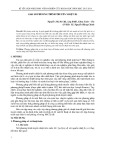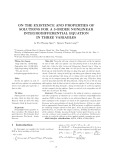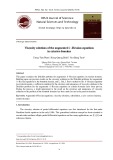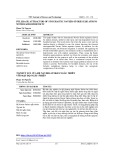
ON THE EXISTENCE AND PROPERTIES OF
SOLUTIONS FOR A 3-ORDER NONLINEAR
INTEGRODIFFERENTIAL EQUATION
IN THREE VARIABLES
Le Thi Phuong Ngoc1∗, Nguyen Thanh Long2,3
1University of Khanh Hoa, 01 Nguyen Chanh Str., Nha Trang City, Vietnam.
2Faculty of Mathematics and Computer Science, University of Science, 227 Nguyen Van Cu Str., Dist. 5,
Ho Chi Minh City, Vietnam.
3Vietnam National University, Ho Chi Minh City, Vietnam.
Thông tin chung: Tóm tắt: Trong bài viết này, chúng tôi chứng minh sự tồn tại nghiệm
Ngày nhận bài: 15/06/2024 và một số tính chất của nghiệm của một phương trình vi tích phân phi
Ngày phản biện: 18/06/2024 tuyến bậc 3 theo ba biến, trong một không gian Banach tùy ý. Công cụ
Ngày duyệt đăng:19/09/2024 chính được sử dụng để nhận được các kết quả là việc áp dụng một cách
∗Tác giả liên hệ: thích hợp các định lý điểm bất động và dạng tổng quát của định lý Ascoli-
lethiphuongngoc@ukh.edu.vn Arzela. Trước hết, chúng tôi thiết lập một không gian Banach tương thích
cho việc giải phương trình đang xét và chứng minh một điều kiện đủ để
Title: các tập con là compact tương đối trong không gian này. Tiếp theo, bằng
Sự tồn tại nghiệm và một số cách sử dụng định lý điểm bất động Banach, chúng tôi xét sự tồn tại duy
tính chất của nghiệm của một phương nhất nghiệm, tính ổn định và tính bị chặn của nghiệm. Cuối cùng, sử dụng
trình vi tích phân phi tuyến bậc 3 định lý điểm bất động Schauder, chúng tôi thảo luận về sự tồn tại nghiệm
theo ba biến và tính compact của tập nghiệm. Ngoài ra, một số ví dụ cũng được nêu để
minh họa các kết quả đạt được.
Từ khóa: Abstract: This paper is devoted to the study of existence, uniqueness
Phương trình vi tích phân theo and other properties of solutions of a 3-order nonlinear integrodifferential
ba biến; Định lý điểm bất động equation (IDE) in three variables in an arbitrary Banach space. The main
Banach; Định lý điểm bất động tools employed in the analysis are based on the applications of fixed point
Schauder; Định lý Ascoli-Arzela. theorems and a generalization of Ascoli-Arzela theorem. At first, we estab-
lish an appropriate Banach space for IDE and prove a sufficient condition
Keywords: for relatively compact subsets in this space. Next, by using Banach’s fixed
Integrodifferential equation in point theorem, we consider the unique existence, stability and boundedness
three variables; The Banach fixed of the solution. Finally, by using Schauder’s fixed point theorem, we dis-
point theorem; The Schauder fixed cuss the existence and compactness of the set of solutions. Furthermore,
point theorem; The Ascoli - Arzela in order to verify the efficiency of the applied method, examples are given.
theorem. AMS Subject classification: 45G10, 47H10, 47N20, 65J15.
1 Introduction
In this paper, we consider the 3-order nonlinear
IDE in three variables of the form
u(x) = g(x)
+ZΩ
K(x, y;u(y), D[1]u(y), D[2]u(y), D[3]u(y))dy,
(1.1)
where x∈Ω = [0,1]3⊂R3, g : Ω →E;
K: Ω×Ω×E4→Eare given functions, (E, ∥·∥E)is a
Banach space, u=u(x)is the unknown function and
D[1]u=D1u=∂u
∂x1
, D[2]u=D2D1u=∂2u
∂x1∂x2
,
D[3]u=D3D2D1u=∂3u
∂x1∂x2∂x3
.
18





